The damage to California from the rain that began on December 16 and continued for three weeks has been extensively written about:

And exhaustively photographed:

According to the Washington Post article, we were hit with:
“Nine separate atmospheric rivers – narrow plumes of deep moisture generated by ocean storms.”

And that, said the article, brought:
- Twenty feet of snow in the central Sierra Nevada.
- A statewide average rainfall of 11.47 inches (though it was much higher – 40 inches and more – in some areas).
- Thirty-two trillion gallons of water.
“Thirty-two trillion gallons of water.”
How do we even imagine that much water?
Let’s try this:
This is Lake Tahoe:

Lake Tahoe straddles the state line between California and Nevada. According to various websites, Lake Tahoe is 22 miles long, 12 miles wide, and the surface area covers 191 square miles.
Lake Tahoe contains an average of 37 trillion gallons of water.
California got almost a Lake Tahoe of rainwater.
But where I live, apparently some in San Diego – also known as “America’s Finest City” – decided that we hadn’t gotten quite enough liquid.
So shortly after the rain stopped, the city added this to the mix:
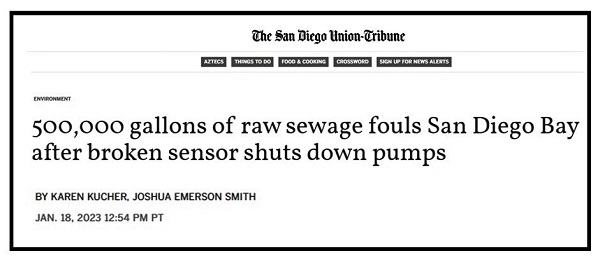
According to the article:
“Sewage flowed out of manholes into streets and storm drains in downtown San Diego and the Midway District…”
Specifically, into 18 different areas in downtown San Diego and the Midway District.
Let’s imagine it.
It’s a Monday, a little past 3pm. You’ve taken some personal time off from work for a dentist appointment. You parked on the street because the dentist’s parking lot was full. After your appointment you head for the street, and this is what greets you:

Thousands of gallons of raw sewage. Your car is sitting in it, up to its hubcaps.
And how do you know it’s raw sewage?
The smell.
You’re going to need a lot more of these:
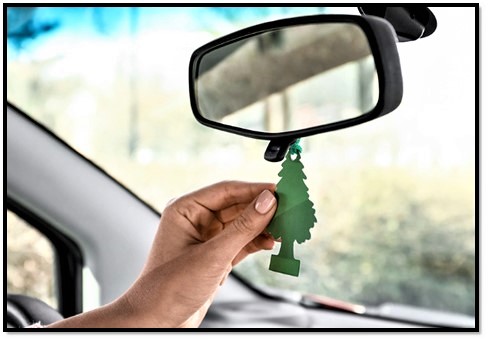
Here’s an image from a video of what the raw sewage looked like, practically geyser-ing out of a manhole:

The person who shot the video described what she saw:
“It looked like a Loch Ness monster coming out of the ground…a two-foot-tall gurgling brown-black mountain of sewage.”
Where did this smelly, filthy nightmare come from?
It came from San Diego’s Pump Station 2.
According to constructionjournal.com:
“Pump Stations 1 (PS-1) and 2 (PS-2) are the largest and most critical pump stations within the City of San Diego’s wastewater collection system.”
Here’s Pump Station 2:

The station was constructed by Swift Lee Office (SLO), a “full-service architecture firm.” On their website they describe Pump Station 2 (PS-2) as follows:

“PS-2 is a critical pump station; nearly 80% of the City’s sewage flows into PS-2 and ultimately into the Point Loma Wastewater Treatment Plant. Thus, it is crucial that PS-2 remain operational throughout an emergency situation.”
Well, PS-2 sure didn’t “remain operational” through this “emergency situation.”
What went wrong at Pump Station 2 and caused the 500,000-gallon raw sewage spill?
According to the Union-Tribune:
“…a sensor malfunction…caused the wastewater pumps to shut down.”
A “sensor malfunction.”
Considering the fact that Swift Lee Office built Pump Station 2, and San Diego paid plenty for Swift Lee Office to do so, I’d like to introduce both to a concept that isn’t new, but apparently unknown to the people involved.
The concept is…

Backup systems.
You know – to back up data, like the Cloud. On airplanes they’re called “redundant systems.” In homes and hospitals they’re called “backup generators.” An extra pair of eyeglasses is a backup system. So are extra rolls of toilet paper. And a useable spare tire in your trunk.

In my purse it’s called, “Having two pens instead of one.”
Pretty simple concept – yes?
Apparently not.
Since the builders and operators of PS-2 knew it was a “critical pump station,” where was the backup in case of a “sensor malfunction”?
Instead of a backup system kicking in at PS-2, raw sewage flowed until the pumps “were manually restarted.”
“Manually restarted” 27 minutes later.
The story made national headlines:

The raw sewage closed beaches:

There were lots of these along miles of our shorelines:

And, says this article:
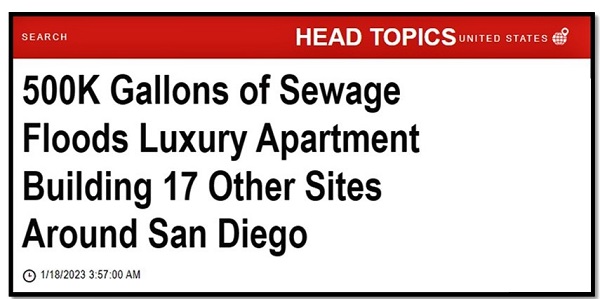
The people who live in Park Place luxury apartments…
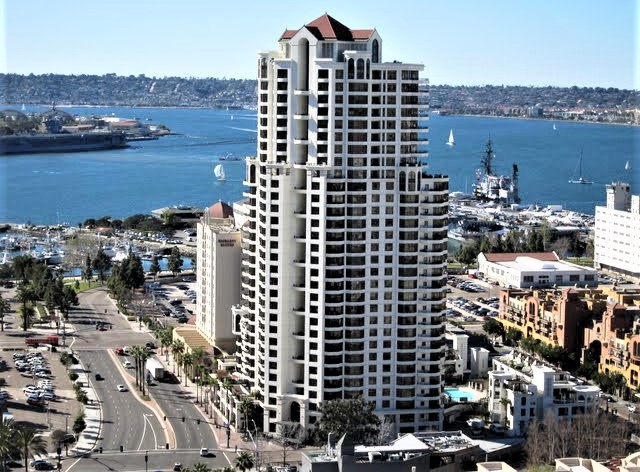
…and multiple other locations were not happy to be sharing their space with…

Raw sewage.
For those folks, the Union-Tribune article offered this consolation – a number to call for assistance:
“Residential and commercial customers who were impacted by the sewage spill were told to call city officials at (619) 515-3525.”
Curious, I called the number.
This is what I heard:

You have reached San Diego’s Get It Done helpline.
If you’re calling about parking issues, press 1.
If you’re calling about illegal dumping, press 2.
If you’re calling about graffiti, press 3.
If your home or business has been impacted by the recent raw sewage spill, hold your nose until further notice.
Goodbye.
OK – I made that up. But I did call the number, and I’ll talk about that in Monday’s Part II.
What caused the “sensor malfunction” at PS-2?
I thought I’d found the answer in the above NBC 7 article, which said:
“A power outage caused the city of San Diego pump station to lose function, a spokesperson for the San Diego County Department of Environmental Health and Quality (DEHQ) said.”
But – strangely, I thought – later the same article said:
“An investigation is underway to determine what caused the sensor malfunction, but on Wednesday afternoon they were able to say it was not due to a power failure.”
So – cause unknown.
The cause of the sensor malfunction is unknown, but the cause of the 27-minute flood of raw sewage seems pretty clear:
No sensor backup system at Pump Station 2:

My takeaway:
As I was researching this story I found an article from 2011 about another raw sewage spill in San Diego, which this time was due to a power outage.
When once again, “America’s Finest City” became “America’s Foulest City.”
I think this succinct – if pungent – headline sums up the situation better than I ever could:
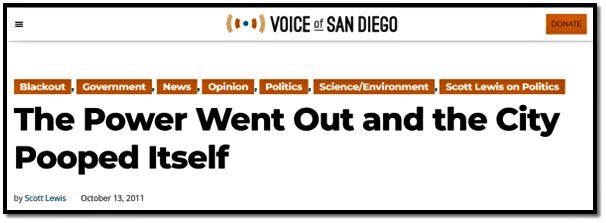
Update: If you think 500,000 gallons of raw sewage is a lot…check out my update on Monday, January 30.


